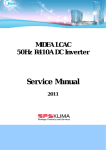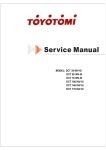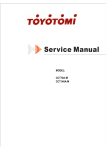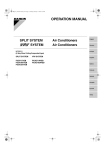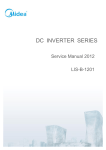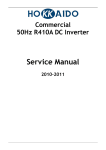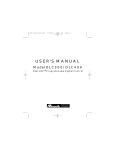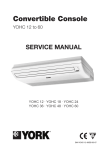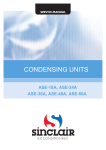Download Ceiling Cassette Inverter Service Manual
Transcript
Contents CONTENTS Part 1 General Information..................................................................................1 Part 2 Indoor Units...............................................................................................6 Part 3 Outdoor Units..........................................................................................32 Part 4 Installation...............................................................................................63 Part 5 Control......................................................................................................74 Contents i General Information Part 1 General Information 1.Model Lists.......................................................................................2 2.External Appearance.......................................................................3 2.1 Indoor Units..................................................................................3 2.2 Outdoor Units...............................................................................3 3.Nomenclature..................................................................................4 4.Features...........................................................................................5 3.Piping Diagrams............................................................................36 General Information 1 Nomenclature 1. Model Lists 1.1 Indoor Units R410A (capacity multiplied by 1000Btu/h) Type Four-way cassette Ceiling & floor Function Cooling Only Cooling Only 24 √ √ 36 √ √ 48 √ √ 1.2 Outdoor Units Compressor type Compressor Brand KV24ODU-ARF21 Rotary DC Inverter GMCC KV36ODU-ARF21 Rotary DC Inverter MITSUBISHI KV48ODU-ARF21 Rotary DC Inverter MITSUBISHI Universal Outdoor unit Model 2 Matched indoor units KV24CC-ARF21 KV24CM-ARF21 KV36CC-ARF21 KV36CM-ARF21 KV48CC-ARF21 KV48CM-ARF21 Indoor Units Features 2. External Appearance 2.1 Indoor Units Four-way Ceiling Cassette Ceiling-floor Mount: Convertible 2.2 Outdoor Units KV24ODU-ARF21 KV36ODU-ARF21 General Information KV48ODU-ARF21 3 Nomenclature 3. Nomenclature 3.1 Indoor Unit F Console Type 3.2 Outdoor Unit 4 Indoor Units Features 4. Features 4.1 Universal outdoor unit design Indoor unit with the same capacity can match with the same outdoor unit. 4.2 High efficiency and energy saving. Thanks to the DC inverter technology and optimized piping system, the EER and COP of whole series can easily reach A-class. 4.3 Low noise and low starting current. Thanks to the DC inverter technology, the system can work with low noise, and very small starting current. 4.4 Intelligent refrigerant adjustment technology. Throttle part is made up of capillary and electronic expansion valve (EXV). The outdoor unit can output the most accurate capacity in any condition. 4.5 Working in cooling mode under -15℃. Outdoor unit built-in with low ambient kit, it can control the outdoor unit’s fan and cooling can be performed throughout the year for computer rooms, banquet halls, etc. Wide operation range covers outdoor temperatures as low as -15℃ for cooling. 4.6 Indoor & outdoor unit’s power supply is separate. 4.7 All indoor units have network control function. 4.8 All indoor units have Auto-restart function. General Information 5 Indoor Units Part 2 Indoor Units Four-way Ceiling Cassette Type ......................................................7 Ceiling & Floor Type.........................................................................20 6 Indoor Units Four-way Ceiling Cassette Type Four-way Ceiling Cassette Type 1.Features...........................................................................................8 2.Dimensions....................................................................................11 3.Service Space................................................................................12 4.Wiring Diagrams............................................................................13 5.Capacity Tables.............................................................................14 6.Air Velocity and Temperature Distributions................................15 7.Electric Characteristics................................................................16 8.Sound Levels.................................................................................16 9.Accessories ..................................................................................17 10.The Specification of Power.........................................................18 11.Field Wiring .................................................................................19 Four-way Ceiling Cassette Type 7 Features 1. Features (1) Low operation noise —Streamline plate ensures quietness —Creates natural and comfortable environment (2) (3) Excellent performance. The optimal evaporator & sufficient airflow volume guarantees the excellent capacity (4) The adoption of the most advanced 3- Dimensional Screw fan —Reduces the air resistance passing through —Smoothes the air flow —Makes air speed distribution to the heat exchange uniform (5) Fresh air makes life healthier and more comfortable. (6) Drainage pump can take up the condenser water to750mm. (7) Ultra thin machine body to easy installation and maintenance. 18K~24K:230mm, 36~48K:300mm. 8 Four-way Cassette Type Features (8) (9) (10) (11) (12) 4 speeds available, optional super high fan speed design suitable for the large building over 3m high. (13) Adding digital tube displaying on the display board. LED can display the Error Code to make the malfunction checking easier. Four-way Ceiling Cassette Type 9 The Specification of Power (14) Reserve spaces for air side-outlet, it is available to connect duct pipe hence air supplying from the four sides to nearby small room.. (15) The connecting pipe and drop height is higher. Max. pipe length up to 50m ( refer to ① ), and Max. drop height up to 30m(refer to ②). (16) Optimal design, smaller Control Box, Space saving and convenient for wiring, Using fire resistance galvanized steel for E-box material. Metal box make the control part more stable and prevent damaging. 10 Four-way Ceiling Cassette Type Field Wiring 2. Dimensions Unit: mm MODEL A B C H KV24CC-ARF21 KV36CC-ARF21 KV48CC-ARF21 230 Ф15.9 Ф9.5 >260 300 Ф15.9 Ф9.5 >330 Four-way Ceiling Cassette Type 11 The Specification of Power 3. Service Space A N ece ssary room intlet A Drain side Tubing side outlet m 05> 2 outlet Chart 1 Note:18000-24000Btu/h(R22) ground Series A≥260m m Series A≥330m m )(lP 0e5n9a )elohgni(C 08 )noitac-(lH 08k6 )(B 0y4d8o 36000-48000Btu/h(R 22) Ho ok B od y 780(Hook-location) 840(Body) 880(Ceiling hole) 950(Panel) B Nut Ce ilin g 88 0m m Pan el Chart 2 Note:18000-2400 0Btu/h(R22 ) 36000-4800 0Btu/h(R22) Chart 4 Series B=240mm Series B=310mm m 0>1 >1000mm Central hole I nstallation pape r board Bolt M6X12 m 0>1 >1000mm B ody (Unit: mm) Chart 3 12 Chart 5 Four-way Ceiling Cassette Type Field Wiring 4. Wiring Diagrams KV24CC-ARF21, KV36CC-ARF21 KV48CC-ARF21 Four-way Ceiling Cassette Type 13 The Specification of Power 5. Capacity Tables 5.1 Cooling Capacity KV24CC-ARF21 Cooling Indoor Conditions 21/15ºC DB/WB 24/17ºC DB/WB 27/19ºC DB/WB 32/23ºC DB/WB Outdoor conditions (DB) (kW) TC SC Input TC SC Input TC SC Input TC SC Input 21ºC 7.52 5.56 2.10 7.74 5.80 2.23 7.88 5.83 2.28 8.03 6.83 2.38 28ºC 7.15 5.51 2.28 7.37 5.75 2.38 7.52 5.79 2.41 7.74 6.73 2.49 (kW) TC SC Input TC SC Input TC SC Input TC SC Input 21ºC 11.33 8.38 3.42 11.66 8.75 3.63 11.88 8.79 3.71 12.10 10.29 3.88 28ºC 10.78 8.30 3.71 11.11 8.67 3.88 11.33 8.72 3.92 11.66 10.14 4.04 (kW) TC SC Input TC SC Input TC SC Input TC SC Input 21ºC 14.42 10.67 3.89 14.84 11.13 4.13 15.12 11.19 4.22 15.40 13.09 4.41 28ºC 13.72 10.56 4.22 14.14 11.03 4.41 14.42 11.10 4.45 14.84 12.91 4.60 35ºC 6.79 5.43 2.38 7.01 5.68 2.49 7.30 5.69 2.54 7.59 6.68 2.66 43ºC 6.50 5.46 2.46 6.57 5.52 2.61 6.79 5.57 2.66 7.01 6.52 2.76 KV36CC-ARF21 Cooling Indoor Conditions 21/15ºC DB/WB 24/17ºC DB/WB 27/19ºC DB/WB 32/23ºC DB/WB Outdoor conditions (DB) 35ºC 10.23 8.18 3.88 10.56 8.55 4.04 11.00 8.58 4.13 11.44 10.07 4.33 43ºC 9.79 8.22 4.00 9.90 8.32 4.25 10.23 8.39 4.33 10.56 9.82 4.50 KV48CC-ARF21 Cooling Indoor Conditions 21/15ºC DB/WB 24/17ºC DB/WB 27/19ºC DB/WB 32/23ºC DB/WB Outdoor conditions (DB) 35ºC 13.02 10.42 4.41 13.44 10.89 4.60 14.00 10.92 4.69 14.56 12.81 4.92 43ºC 12.46 10.47 4.55 12.60 10.58 4.83 13.02 10.68 4.92 13.44 12.50 5.11 Notes: TC : Total capacity ; kW SC: Sensible heat capacity ; kW Input: Input power; kW 14 Four-way Ceiling Cassette Type Field Wiring 6. Air Velocity and Temperature Distributions Airflow velocity Temperature Four-way Ceiling Cassette Type 15 The Specification of Power 7. Electric Characteristics Model Indoor Unit Power Supply Hz Voltage Min Max MFA KV24CC-ARF21 60 220-240 198 254 15 KV36CC-ARF21 60 220-240 198 254 15 KV48CC-ARF21 60 220-240 198 254 15 Notes: MFA: Max. Fuse Amps. (A) 8. Sound Levels FOUR-W AY CASSE TTE TYPE 1.0m Microphone Model 16 Noise level dB(A) H M L KV24CC-ARF21 42 40.5 39 KV36CC-ARF21 44 42.5 41 KV48CC-ARF21 44 42 41 Four-way Cassette Type Field Wiring 9. Accessories Name INSTALLATION FITTINGS Tubing & Fittings Drainpipe Fittings Remote controller & Its Frame Others Installation accessory (The product you have might not be provided the following accessories Shape Quantity Installation paper board 1 Soundproof / insulation sheath 2 Connecting pipe group 1 Out-let pipe sheath 1 Out-let pipe clasp 1 Drain joint 1 Seal ring 1 Remote controller & Its Frame 1 Remote controller holder 1 Mounting screw(ST2.9×10-C-H) 2 Alkaline dry batteries (AM4) 2 Owner's manual 1 Installation manual 1 Expansible hook 4 Installation hook 4 Orifice 1 Four-way Ceiling Cassette Type 17 The Specification of Power 10. The Specification of Power Phase 1- Phase KV36CC-ARF21 KV48CC-ARF21 1- Phase Frequency and Voltage 220-240V~, 60Hz 220-240V~, 60Hz Power Wiring(mm2) 3X1.0 3X1.0 Circuit Breaker(A) 15 15 Phase 1- Phase 1- Phase Frequency and Voltage 220-240V~,60Hz 220-240V~,60Hz Power Wiring(mm2) 3X2.5 3X3.3 Circuit Breaker(A) 30 40 Indoor/outdoor connection wiring(Weak Electric Signal) (mm2) 3X0.5 3X0.5 Indoor/outdoor connection wiring(Strong Electric Signal) (mm2) — — Type KV24CC-ARF21 Indoor unit Power Outdoor unit Power 18 Four-way Cassette Type Field Wiring 11. Field Wiring Wiring chart KV24CC-ARF21, KV36CC-ARF21, KV48CC-ARF21 Four-way Ceiling Cassette Type 19 Ceiling & Floor Type Ceiling & Floor Type 1.Features.........................................................................................21 2.Dimensions ...................................................................................22 3.Service Space................................................................................23 4.Wiring Diagrams............................................................................23 5.Capacity Tables.............................................................................24 6.Air Velocity and Temperature Distributions................................26 7.Electric Characteristics................................................................28 8.Sound Levels ................................................................................28 9.Accessories ..................................................................................29 10.The Specification of Power ........................................................30 11.Field Wiring..................................................................................31 20 Ceiling & Floor Type Field Wiring 1. Features 1.1. New design, more modern and elegant appearance. 1.2. Convenient installation --The ceiling type can be easily installed into a corner of the ceiling even if the ceiling is very narrow --It is especially useful when installation of an air conditioner in the center of the ceiling is impossible due to a structure such as one lighting. 1.3. Two direction auto swing (vertical & horizontal) and wide angle air flow, --Air flow directional control minimizes the air resistance and produces wilder air flow to vertical direction. --The range of horizontal air discharge is widened which secures wider air flow distribution to provide more comfortable air circulation no matter where the unit is set up 1.4. Three level fan speed, more humanism design, meets different air-supply requirement. 1.5. Water proof by utilizing the absorbing plastic film on water collector 1.6. Easy operation. 1.7. Remote control and optional wired control method. Ceiling & Floor Type 21 The Specification of Power 2. Dimensions a. Wall mounting installation b. Ceiling installation Capacity (Btu/h) 22 A B C D E F G KV24CM-ARF21 990 660 203 505 KV36CM-ARF21 1280 660 203 795 506 907 200 506 1195 200 KV48CM-ARF21 1670 680 240 1070 450 1542 200 Ceiling & Floor Type Field Wiring 3. Service Space Ceiling & Floor Type 23 The Specification of Power 4. Wiring Diagrams KV24CM-ARF21, KV36CM-ARF21 KV48CM-ARF21 24 Ceiling & Floor Type Field Wiring 5. Capacity Tables 6.1 Cooling Capacity KV24CM-ARF21 Cooling Indoor Conditions 21/15ºC DB/WB 24/17ºC DB/WB 27/19ºC DB/WB 32/23ºC DB/WB Outdoor conditions (DB) (kW) TC SC Input TC SC Input TC SC Input TC SC Input 21ºC 7.52 5.56 2.10 7.74 5.80 2.23 7.88 5.83 2.28 8.03 6.83 2.38 28ºC 7.15 5.51 2.28 7.37 5.75 2.38 7.52 5.79 2.41 7.74 6.73 2.49 35ºC 6.79 5.43 2.38 7.01 5.68 2.49 7.30 5.69 2.54 7.59 6.68 2.66 43ºC 6.50 5.46 2.46 6.57 5.52 2.61 6.79 5.57 2.66 7.01 6.52 2.76 KV36CM-ARF21 High speed Indoor Conditions 21/15ºC DB/WB 24/17ºC DB/WB 27/19ºC DB/WB 32/23ºC DB/WB (kW) TC SC Input TC SC Input TC SC Input TC SC Input 21ºC 10.82 8.00 3.44 11.13 8.35 3.64 11.34 8.39 3.73 11.55 9.82 3.89 (kW) TC SC Input TC SC Input TC SC Input TC SC Input 21ºC 14.42 10.67 3.89 14.84 11.13 4.13 15.12 11.19 4.22 15.40 13.09 4.41 Indoor conditions (DB) at 0Pa 28ºC 35ºC 10.29 9.77 7.92 7.81 3.73 3.89 10.61 10.08 8.27 8.16 3.89 4.06 10.82 10.50 8.33 8.19 3.93 4.14 11.13 10.92 9.68 9.61 4.06 4.35 43ºC 9.35 7.85 4.02 9.45 7.94 4.26 9.77 8.01 4.35 10.08 9.37 4.51 KV48CM-ARF21 Cooling Indoor Conditions 21/15ºC DB/WB 24/17ºC DB/WB 27/19ºC DB/WB 32/23ºC DB/WB Outdoor conditions (DB) 28ºC 13.72 10.56 4.22 14.14 11.03 4.41 14.42 11.10 4.45 14.84 12.91 4.60 35ºC 13.02 10.42 4.41 13.44 10.89 4.60 14.00 10.92 4.69 14.56 12.81 4.92 43ºC 12.46 10.47 4.55 12.60 10.58 4.83 13.02 10.68 4.92 13.44 12.50 5.11 Notes: TC : Total capacity ; kW SC: Sensible heat capacity ; kW Input: Input power; kW Ceiling & Floor Type 25 The Specification of Power 6. Air Velocity and Temperature Distributions Discharge angle 60° (CEILING) Airflow velocity Temperature 26 Ceiling & Floor Type Field Wiring Discharge angle 60°(FLOOR) Airflow velocity Temperature Ceiling & Floor Type 27 The Specification of Power 7. Electric Characteristics Model KV24CM-ARF21 KV36CM-ARF21 KV48CM-ARF21 Hz 60 60 60 Indoor Unit Voltage Min 220-240 198 220-240 198 220-240 198 Power Supply MFA 15 15 15 Max 254 254 254 Notes: MFA: Max. Fuse Amps. (A) 8. Sound Levels Ceiling Model 28 Floor Noise level dB(A) H M L KV24CM-ARF21 45 43 40 KV36CM-ARF21 45 43 40 KV48CM-ARF21 47 46 44 Ceiling & Floor Type Field Wiring 9. Accessories Name Shape Quantity 1.Hook 2 2.Hanging arm 2 3. Remote controller 1 4. Remote controller holder 1 5. Mounting screw (ST2.9×10-C-H) 2 6. Alkaline dry batteries (AM4) 2 7. Owner's manual 1 8. Installation manual 1 9. Remote controller manual 1 Installation fittings Remote controller & Its holder Others Ceiling & Floor Type 29 The Specification of Power 10. The Specification of Power Phase KV24CM-ARF21 KV36CM-ARF21 KV48CM-ARF21 1- Phase Frequency and Voltage 220V~,60Hz Power Wiring(mm2) 3X1.0 Circuit Breaker(A) 15 Phase 1- Phase Frequency and Voltage 220V~,60Hz Power Wiring(mm2) 3X3.3 Circuit Breaker(A) 40 Type Indoor unit Power Outdoor unit Power Indoor/outdoor connection wiring(Weak Electric Signal) (mm2) 3X0.5 Indoor/outdoor connection wiring(Strong Electric Signal) (mm2) — 30 Ceiling & Floor Type Field Wiring 11. Field Wiring Wiring chart Ceiling & Floor Type 31 Outdoor Unit Part 3 Outdoor Units 1.Dimensions....................................................................................33 2.Service Space ...............................................................................35 4.Wiring Diagrams............................................................................37 5.Electric Characteristics................................................................40 6.Operation Limits............................................................................41 7.Sound Levels.................................................................................42 8.Troubleshooting............................................................................43 32 Outdoor Unit Operation Limits 1. Dimensions Unit: mm MODEL A B C D E F H KV24ODU-ARF21 842 560 335 360 312 324 695 KV36ODU-ARF21 990 624 366 396 340 354 966 Outdoor Units 33 Electric Characteristics Unit: mm MODEL KV48ODU-ARF21 34 A B C D E F H 940 600 376 400 340 360 1245 Outdoor Units Operation Limits 2. Service Space (Wall or obstacle) Air inlet More than 30cm Air inlet More than 60cm Maintain channel More than 60cm Air outlet Outdoor Units More than 30cm More than 200cm 35 Electric Characteristics 3. Piping Diagrams KV24ODU-ARF21, KV36ODU-ARF21 INDOOR OUTDOOR CAPILIARY TUBE LIQUID SIDE Electronic expansion valve T3 Condenser temp. sensor HEAT EXCHANGE (EVAPORATOR) T1 Room temp. sensor T4 Ambient temp. sensor HEAT EXCHANGE (CONDENSER) T2 Evaporator temp. sensor Accumulator GAS SIDE T5 Discharge temp. sensor COMPRESSOR Notes: KV24ODU-ARF21(220075301740) & KV36ODU-ARF21(220075502120) have no EXV. KV48ODU-ARF21 INDOOR OUTDOOR LIQUID SIDE CAPILIARY TUBE Electronic expansion valve T3 Condenser temp. sensor HEAT EXCHANGE (EVAPORATOR) T1 Room temp. sensor T4 Ambient temp. sensor HEAT EXCHANGE (CONDENSER) T2 Evaporator temp. sensor T5 Discharge temp. sensor GAS SIDE Oil separator COMPRESSOR Oil return Capillary 36 Outdoor Units Operation Limits 4. Wiring Diagrams KV24ODU-ARF21(220075301510) KV24ODU-ARF21(220075301740) Outdoor Units 37 Electric Characteristics KV36ODU-ARF21(220075501730) KV36ODU-ARF21(220075502120) 38 Outdoor Units Operation Limits KV48ODU-ARF21 Outdoor Units 39 Electric Characteristics 5. Electric Characteristics Model 40 Outdoor Unit Hz Voltage Min. Max. KV24ODU-ARF21 60 220-240 198 254 KV36ODU-ARF21 60 220-240 198 254 KV48ODU-ARF21 60 220-240 198 254 Outdoor Units Operation Limits 6. Operation Limits Temperature Mode Cooling operation ≥17℃ Room temperature 0℃~50℃ Outdoor temperature (-15℃~50℃:For the models with low temperature cooling system) CAUTION: 1. If the air conditioner is used beyond the above conditions, certain safety protection features may come into operation and cause the unit to operate abnormally. 2. The room relative humidity should be less than 80%. If the air conditioner operates beyond this figure, the surface of the air conditioner may attract condensation. Please set the vertical air flow louver to its maximum angle (vertically to the floor), and set HIGH fan mode. 3. The optimum performance will be achieved during this operating temperature zone. Outdoor Units 41 Electric Characteristics 7. Sound Levels Outdoor Unit Microphone H 1.0m Note: H= 0.5 × height of outdoor unit 42 Model Noise level dB(A) KV24ODU-ARF21 54 KV36ODU-ARF21 55 KV48ODU-ARF21 60 Outdoor Units Operation Limits 8. Troubleshooting 9.1 Indoor unit malfunction 9.1.1 Display board Normal 4-way cassette Ceiling & Floor Outdoor Units 43 Electric Characteristics 9.1.2 Troubleshooting NO. Malfunction Running lamp Timer lamp Defrosting lamp Alarm lamp Display(nixie tube) 1 Communication malfunction between indoor and outdoor units. X ☆ X X E1 2 Open or short circuit of T1 temperature sensor ☆ X X X E2 3 Open or short circuit of T2 temperature sensor ☆ X X X E3 4 Open or short circuit of T2B temperature sensor ☆ X X X E4 5 Full-water malfunction X X X ☆ EE 6 EEPROM malfunction X X ☆ X E7 7 Outdoor unit malfunction X X X ◎ Ed X(off) ☆(flash at 5Hz) ◎(flash at 0.5Hz) 1. Running lamp flashes Judge 1: Indoor temp. sensor is abnormal Running lamp flashes at 5Hz Judge 1: Indoor temp. sensor is abnormal Running lamp flashes at 5Hz No Check whether the resistance of the evaporator temp. sensor is correct according to Annex 1 Yes Judge 2: Room temp. sensor is abnormal Check whether the resistance of the room temp. sensor is correct according to Annex 1 No Replace room temp. sensor Yes Replace indoor PCB 44 Outdoor Units Operation Limits 2. Timer lamp flashes Timer lamp flashes at 5Hz Judge: Indoor/outdoor unit communication is abnormal Refer to the outdoor unit LED display E2 malfunction in the following part 3. Alarm lamp slow-flash Indoor alarm lamps flash at 1Hz Condenser temp. sensor or outdoor unit is malfunction Judge 1: Condenser temp. sensor is abnormal Check whether the resistance of the condenser temp. sensor is correct according to Annex 1 No Replace condenser temp. sensor Yes Judge 2: Outdoor unit is abnormal Refer to the outdoor unit LED display E4 、P1 、P2 malfunction in the following part Outdoor Units 45 Electric Characteristics 4. Alarm lamp quick-flash Alarm lamp flashes at 5Hz Judge: Water level switch is abnormal. No Replace water pump Check whether the water pump can work normally Yes Select the cooling mode to make water pump work for a few minutes, then check whether the system can run normally Yes Trouble is solved No Yes Check whether the water drain pipe is blocked Solve to make the water can flow fluently No Replace indoor PCB 5. Defrost lamp flashes Defrost lamp flashes Judge: Mode conflicts malfunction Turn the indoor unit to heating mode or turn off the unit 46 Outdoor Units Operation Limits 9.2 Outdoor unit malfunction Display Malfunction or Protection E0 EEPROM malfunction E2 Communication malfunction between indoor IC and outdoor IC E3 Communication malfunction in outdoor IC and DSP E4 Malfunction of outdoor temperature sensor E5 Voltage protection of compressor E6 PFC module protection (Only for 36K, 48K) P0 Top temperature protection of compressor P1 High pressure protection P2 Low pressure protection P3 Current protection of compressor P4 Discharge temperature protection of compressor P5 High temperature protection of condenser P6 Module protection P7 High temperature protection of evaporator 1. E0 malfunction E0 display EEPROM malfunction Judge: Check whether the EEPROM is inserted well No Insert the EEPROM well Yes Replace outdoor main board Outdoor Units 47 Electric Characteristics 2. E2 malfunction E2 display Communication malfunction between indoor IC and outdoor IC Judge 1: Check whether the indoor unit power is on No Turn on the indoor unit power Yes Judge 2: Check whether the signal wiring is shield cable or whether the shield cable is earthed No Adopt the shield cable/ let shield cable earthed Yes No Judge 3: Check whether the signal wiring between the indoor and outdoor units is wrong polarity? Judge 4: Check whether the signal wiring between the indoor and outdoor units is broken? Yes Connect the signal wiring correctly Yes Replace the broken wiring No Indoor or outdoor main board is broken. Replace the main board until the malfunction disappears. 48 Outdoor Units Operation Limits 3. E3 malfunction (For 18K & 24K & 30K) E3 display Communication malfunction in outdoor IC and DSP Yes Check whether the indicator lights LED1 on the main board is flashing Replace the outdoor main board No Check whether the connecting wiring between the IPM module and the CN4 on the main board is broken off Yes Insert the connecting wiring well over again No Disconnect the connecting wiring between the IPM module and the CN4 on the main board, use the multimeter to measure the voltage between the IPM module CN1 port’s 3 and 4 pillar, check whether it is 5V, (the third pillar on the main board labels +5V) Yes Replace outdoor main board No Check whether the connecting wiring between the IPM module positive pole and the CN12 on the power board is broken off Yes Insert the connecting wiring well over again No Check whether the connecting wiring between the IPM module negative pole and the CN13 on the power board is broken off Yes Insert the connecting wiring well over again No Use the multimeter to measure whether the voltage between the CN12 and the CN13 on the power board is between + ( 277V~345 ) V Yes Replace the IPM module No Replace the power board Outdoor Units 49 Electric Characteristics 4. E3 malfunction (For 36K & 48K & 60K) E3 display Communication malfunction in outdoor IC and DSP Check whether the indicator lights LED1 or LED2 on the main control board are flashing Yes Replace PCB No Install the IC-U3 chip of the PCB over again, check whether the system can run normally Yes Trouble is solved No Yes Check whether the output of the transformer to CN4 socket is well Replace PCB No Replace the transformer 50 Outdoor Units Operation Limits 5. E4 malfunction E4 display Judge 1: Outdoor condenser temp. sensor (T3) is malfunction Yes Connect the wiring well Check whether the wiring of the condenser temp. sensor is broken off No Check whether the resistance of condenser temp. sensor is wrong refer to the Annex 1 Yes Replace condenser temp. sensor No Judge 2: Outdoor ambient temp. sensor (T4) is malfunction Yes Check whether the wiring of the outdoor ambient temperature sensor (T4) is broken off Connect the wiring well No Check whether the resistance of outdoor ambient temperature sensor (T4) is wrong refer to the Annex 1 Yes Replace outdoor ambient temperature sensor (T4) No Replace PCB Outdoor Units 51 Electric Characteristics 6. E5 malfunction E5 display Voltage protection of compressor Check the voltage of outdoor unit power supply, whether the voltage between L(1) and N is about 172-265V No Check the power supply Yes Replace the power board, then check whether the system can run normally Yes Trouble is solved No Replace outdoor main board 7. E6 malfunction (Only for 30K, 36K with 1 phase) E6 display PFC module protection Check whether the connecting line between main board and the PFC module is connected tightly No Connect it tightly, check normal or not No Yes Check whether the voltage between P and N of IPM module is 380-390V Yes Replace the outdoor main board No Replace the PFC module 52 Outdoor Units Operation Limits 8. P0 malfunction P0 display Top temperature protection of compressor Judge 1: Whether compressor operates? Yes Judge 2: Whether refrigerant circulation volume is normal? No No Whether the connection is good? No Reconnect and retest. Yes Whether protector is normal? No Replace the protector. Yes Yes Method: Charge refrigerant Check the outdoor main PCB. Is there some problem? Replace the protector. Whether abnormality is the same after gas charging? No Check refrigerant system (such as clogging of capillary etc.) Outdoor Units 53 Electric Characteristics 9. P1 malfunction P1 display High pressure protection No Judge 1: Whether the wiring between the high pressure switch and main control board is connected well or correctly Connect it well Yes Judge 2: Whether the high pressure switch is broken Yes Method: Short connect the high pressure switch socket, check whether the system can run normally Replace high pressure switch No Check whether the refrigerant system is ok Yes Judge 3: Check whether the outdoor ambient temperature is too high No Stop the unit Yes Make the outdoor unit ventilate well Judge 4: Check whether the outdoor unit is bad ventilation No Yes Clean the heat exchanger Judge 5: Check whether the heat exchanger is dirty No Yes Judge 6: Check whether the refrigerant pipe is blocked Let the refrigerant out, then use the high pressure nitrogen or refrigerant to blow pipe, vacuumize and charge the refrigerant again No Replace outdoor main board 54 Outdoor Units Operation Limits 10. P2 malfunction P2 display Low pressure protection Judge 1: The wiring between the low pressure switch and main control board is connected well or correctly No Connect it well Yes Judge 2: Whether the low pressure switch is broken Yes Method: Short connect the low pressure switch socket, check whether the system can run normally Replace low pressure switch No Check whether the refrigerant system is ok Yes Judge 3: Check whether the outdoor ambient temperature is too low Stop the unit No Judge 4: The refrigerant of the system is leakage Method: Connect the pressure gauge to the gauge joint of the system, check whether the pressure is lower than 0.14MPa Yes Leak hunting: Charge nitrogen or refrigerant to the system, if the leakage is serious, there will be distinct gas leakage “cici” sound; if the leakage is slight, use the suds (mixture of water and abluent is also ok if it can make bubble) or electronic leak detector. No Yes Judge 5: The refrigerant pipe is blocked Let the refrigerant out, then use the high pressure nitrogen or refrigerant to blow pipe, vacuumize and charge the refrigerant again No Replace outdoor main board Outdoor Units 55 Electric Characteristics 11. P3 malfunction P3 display Current protection of compressor Judge 1: Check whether the input current of the power supply wire is more than 20A (For 36K & 48K with 1 phase, it is 30A) Yes Check whether the refrigerant system is ok Yes Judge 2: Check whether the outdoor ambient temperature is too high No Stop the unit Yes Make the outdoor unit ventilate well Judge 3: Check whether the outdoor unit is bad ventilation No Yes Clean the heat exchanger Judge 4: Check whether the heat exchanger is dirty No Yes Judge 5: The refrigerant pipe is blocked Let the refrigerant out, then use the high pressure nitrogen or refrigerant to blow pipe, vacuumize and charge the refrigerant again No Replace outdoor main board 56 Outdoor Units Operation Limits 14. P6 malfunction (For single phase units) P6 display Module protection Check whether the voltage range of P-N on IPM module is normal? DC277-356V for 18K/24K/30KBtu/h; DC277-410V for 36K/48KBtu/h No Check whether the input power supply is correct? 220-240V, 1N, 60Hz Yes Regulate it to correct, then check whether the system can work normally? No Yes No Check whether the connecting line between main board and the IPM module is connected tightly No Connect it tightly, check ok or not? Yes No Check whether the connecting line of the compressor is connected correctly or tightly No Check whether the power supply line is connected correctly and tightly No Connect it correctly and tightly, check ok or not? No Yes Connect it well, check ok or not? Check whether the lines in Epart box are connected tightly No Connect it tightly, check ok or not? Yes No No Yes Replace the IPM module, check whether the system can work normally? No Check whether the single-phase bridge is normal? Use the multimeter to measure the resistance between each two terminals, check whether there is the condition that value of resistance is 0 Yes Yes Replace the singlephase bridge Trouble is solved No Replace the main board, check whether the system can work normally? Yes Trouble is solved Check whether the connecting line of every reactor is normal? If the line is broken, the resistance of the two ports is ∞ No Replace the connecting line No Replace the compressor, check whether the system can work normally? Yes Trouble is solved Yes Check whether the fuse on the power board is normal? No Replace with the same model fuse Yes Replace the power board Outdoor Units 59 Electric Characteristics 15. P6 malfunction (For three phases units) P6 display Module protection No Check whether the voltage range of P-N on IPM module is normal? DC 350-650V Check whether the input power supply is correct? 380-415V, 3N, 60Hz Yes Regulate it to correct, then check whether the system can work normally? No Yes No Check whether the connecting line between main board and the IPM module is connected tightly Connect it tightly, check ok or not? Yes Check whether the connecting line of the compressor is connected tightly No Check whether the power supply line is connected correctly and tightly No No Yes No Check whether the lines in Epart box are connected tightly Connect it tightly, check ok or not? Yes Yes Replace the IPM module, check whether the system can work normally? No Yes Trouble is solved Replace the main board, check whether the system can work normally? Connect it tightly, check ok or not? No No Check whether the three phase bridge is normal? Replace the three phase bridge Yes Check whether the 3300µF/400V electrolytic capacitor is normal? No Connect it correctly and tightly, check ok or not? Yes Trouble is solved Yes Trouble is solved No Replace this electrolytic capacitor No Replace the compressor , check whether the system can work normally? 16. P7 malfunction 60 Outdoor Units Operation Limits P7 display High temperature protection of evaporator Whether compressor operates? Yes Check whether the heat exchanger is dirty, the airoutlet is blocked and the indoor fan is normal? Yes Clean the heat exchanger and the air-outlet No Whether the connection is good? No Reconnect and retest. Yes Whether temperature is normal? the sensor No Replace the temperature sensor No Replace the indoor PCB Yes Whether the indoor PCB is normal? Check whether the indoor fan is normal No Check refrigerant system (such as clogging of capillary etc.) Outdoor Units 61 Electric Characteristics Appendix Indoor Temp. and Pipe Temp. Sensor Resistance Value Table (℃--K) K Ohm ℃ K Ohm ℃ K Ohm ℃ K Ohm -20 115.266 20 12.6431 60 2.35774 100 0.62973 -19 108.146 21 12.0561 61 2.27249 101 0.61148 -18 101.517 22 11.5000 62 2.19073 102 0.59386 -17 96.3423 23 10.9731 63 2.11241 103 0.57683 -16 89.5865 24 10.4736 64 2.03732 104 0.56038 -15 84.2190 25 10.000 65 1.96532 105 0.54448 -14 79.3110 26 9.55074 66 1.89627 106 0.52912 -13 74.5360 27 9.12445 67 1.83003 107 0.51426 -12 70.1698 28 8.71983 68 1.76647 108 0.49989 ℃ 62 -11 66.0898 29 8.33566 69 1.70547 109 0.48600 -10 62.2756 30 7.97078 70 1.64691 110 0.47256 -9 58.7079 31 7.62411 71 1.59068 111 0.45957 -8 56.3694 32 7.29464 72 1.53668 112 0.44699 -7 52.2438 33 6.98142 73 1.48481 113 0.43482 -6 49.3161 34 6.68355 74 1.43498 114 0.42304 -5 46.5725 35 6.40021 75 1.38703 115 0.41164 -4 44.0000 36 6.13059 76 1.34105 116 0.40060 -3 41.5878 37 5.87359 77 1.29078 117 0.38991 -2 39.8239 38 5.62961 78 1.25423 118 0.37956 -1 37.1988 39 5.39689 79 1.21330 119 0.36954 0 35.2024 40 5.17519 80 1.17393 120 0.35982 1 33.3269 41 4.96392 81 1.13604 121 0.35042 2 31.5635 42 4.76253 82 1.09958 122 0.3413 3 29.9058 43 4.57050 83 1.06448 123 0.33246 4 28.3459 44 4.38736 84 1.03069 124 0.32390 5 26.8778 45 4.21263 85 0.99815 125 0.31559 6 25.4954 46 4.04589 86 0.96681 126 0.30754 7 24.1932 47 3.88673 87 0.93662 127 0.29974 8 22.5662 48 3.73476 88 0.90753 128 0.29216 9 21.8094 49 3.58962 89 0.87950 129 0.28482 10 20.7184 50 3.45097 90 0.85248 130 0.27770 11 19.6891 51 3.31847 91 0.82643 131 0.27078 12 18.7177 52 3.19183 92 0.80132 132 0.26408 13 17.8005 53 3.07075 93 0.77709 133 0.25757 14 16.9341 54 2.95896 94 0.75373 134 0.25125 15 16.1156 55 2.84421 95 0.73119 135 0.24512 16 15.3418 56 2.73823 96 0.70944 136 0.23916 17 14.6181 57 2.63682 97 0.68844 137 0.23338 18 13.9180 58 2.53973 98 0.66818 138 0.22776 19 13.2631 59 2.44677 99 0.64862 139 0.22231 Outdoor Units Installation Part 4 Installation 1.Precaution on Installation.............................................................64 2.Vacuum Dry and Leakage Checking............................................65 3.Additional Refrigerant Charge ....................................................67 4.Water Drainage..............................................................................68 5.Insulation Work ...........................................................................71 6.Wiring.............................................................................................72 7.Test Operation...............................................................................73 Installation 63 Test Operation 2. Vacuum Dry and Leakage Checking 1) Vacuum Dry: use vacuum pump to change the moisture (liquid) into steam (gas) in the pipe and discharge it out of the pipe to make the pipe dry. Under one atmospheric pressure, the boiling point of water(steam temperature) is 100℃. Use vacuum pump to make the pressure in the pipe near vacuum state, the boiling point of water falls relatively. When it falls under outdoor temperature, the moisture in the pipe will be vaporized. Necessary vacuum degree 2) Vacuum dry procedure There are two methods of vacuum dry due to different construction environment: common vacuum dry, special vacuum dry. ①. Common vacuum dry procedure Vacuum dry (for the first time)---connect the all-purpose detector to the inlet of liquid pipe and gas pipe, and run the vacuum pump more than two hours (the vacuum pump should be below -755mmHg) If the pump can’t achieve below -755mmHg after pumping 2 hours, moisture or leakage point will still exist in the pipe. At this time, it should be pumped 1 hour more. If the pump can’t achieve -755mmHg after pumping 3 hours, please check if there are some leakage points. Vacuum placement test: place 1 hour when it achieves -755mmHg, pass if the vacuum watch shows no rising. If it rises, it shows there’s moisture or leakage point. Vacuuming from liquid pipe and gas pipe at the same time. Sketch map of common vacuum dry procedure. 65 Water Drainage ②. Special vacuum dry procedure This vacuum dry method is used in the following conditions: There’s moisture when flushing the refrigerant pipe. Rainwater may enter into the pipe. Vacuum dry for the first time ······ 2h pumping ③. Vacuum destroy for the second time ······ Fill nitrogen to 0.5Kgf/cm2 Because nitrogen is for drying gas, it has vacuum drying effect during vacuum destroy. But if the moisture is too much, this method can’t dry thoroughly. So, please pay more attention to prevent water entering and forming condensation water. ④. Vacuum dry for the second time······1h pumping Determinant: Pass if achieving below -755mmHg. If -755mmHg can’t be achieved in 2h, repeat procedure ③ and ④. ⑤. Vacuum placing test ······ 1h ⑥. Sketch map of special vacuum dry procedure 66 Test Operation 3. Additional Refrigerant Charge Caution: a) Refrigerant cannot be charged until field wiring has been completed. b) Refrigerant may only be charged after performing the leak test and the vacuum pumping. c) When charging a system, care shall be taken that its maximum permissible charge is never exceeded, in view of the danger of liquid hammer. d) Charging with an unsuitable substance may cause explosions and accidents, so always ensure that the appropriate refrigerant is charged. e) Refrigerant containers shall be opened slowly. f) Always use protective gloves and protect your eyes when charging refrigerant. The outdoor unit is factory charged with refrigerant. Calculate the added refrigerant according to the diameter and the length of the liquid side pipe of the outdoor unit/indoor unit. R(g) D(mm) L(m) Less than 5m (One-way) φ6.4 Φ9.5 Φ12.7 — — — 30g/m×(L-5) 60g/m×(L-5) Added Refrigerant When 11g/m×(L-5) Over 5m(One-way) Remark: R (g): Additional refrigerant to be charged L (m): The length of the refrigerant pipe (one-way) D (mm): Liquid side piping diameter 67 Water Drainage 4. Water Drainage 4.1 Gradient and Supporting 1). Keep the drainpipe sloping downwards at a gradient of at least 1/50. Keep the drainpipe as short as possible and eliminate the air bubble. 2). The horizontal drainpipe should be short. When the pipe is too long, a prop stand must be installed to keep the gradient of 1/50 and prevent bending. Refer to the following table for the specification of the prop stand. Material Diameter Distance between the prop stands Hard PVC pipe 25~40mm 1.5~2m 3). Precautions ① The diameter of drainpipe should meet the drainage requirement at least. ② the drainpipe should be heat-insulated to prevent atomization. ③ Drainpipe should be installed before installing indoor unit. After powering on, there is some water in water-receiver plate. Please check if the drain pump can operate correctly. ④ All connection should be firm. ⑤ Wipe color on PVC pipe to note connection. ⑥ Climbing, horizontal and bending conditions are prohibited. ⑦ The dimension of drainpipe can’t less than the connecting dimension of indoor drainpipe. ⑧ Heat-insulation should be done well to prevent condensation. ⑨ Indoor units with different drainage type can’t share one convergent drainpipe. 4.2 Drainpipe Trap 1). If the pressure at the connection of the drainpipe is negative, it needs to design drainpipe trap. 2). Every indoor unit needs one drainpipe trap. 3). A plug should be designed to do cleaning. 4.3 Upwards drainage (drain pump) For Four-way cassette(compact) 68 50cm 50cm Plug Test Operation For Four-way cassette 4.4 Convergent drainage 1). The number of indoor units should be as small as possible to prevent the traverse main pipe overlong. 2). Indoor unit with drain pump and indoor unit without drain pump should be in different drainage system. 3). Selecting the diameter Number of connecting indoor units → Calculate drainage volume → Select the diameter Calculate allowed volume =Total cooling capacity of indoor units (HP)×2 (l/ hr) Material Allowed volume(lean 1/50) (l/ hr) I.D. (mm) Thick Hard PVC Hard PVC Hard PVC Hard PVC Hard PVC ∽≤14 14<∽≤88 88<∽≤334 175<∽≤334 334<∽ ¢25 ¢30 ¢40 ¢50 ¢80 3.0 3.5 4.0 4.5 6.0 4.5 Drainage test 1). Drainage without drain pump After finishing drainpipe installation, pour some water into the water receiver plate to check if the water flows smoothly. 2). Drainage with drain pump ① Poke the Water Level Switch, remove the cover, use water pipe to pour 2000ml water into the water receipt plate through the water inlet. ② Turn on the power to Cooling operation. Check the pump’s operation and switch on the Water Level Switch. Check the pump’s sound and look into the transparent hard pipe in the outlet at the same time to check if the water can discharge normally. 69 Water Drainage ③ Stop the air conditioner running, turn off the power, and put back the cover. Stop the air conditioner. After 3 minutes, check if it has abnormity. If the collocation of drainpipes is illogical, the water will flow back overfull, which will cause the alarm lamp flashes, even overflow from the water receipt plate. Keep on pouring water until it gives an alarm signal for high water level, check if the pump drains water at once. If the water level can’t fall below the alarmed water level after 3 minutes, the air conditioner will stop. Turn off the power and drain the remained water, and then turn on the air conditioner. Note: the drain stuff in the main water receipt plate is for maintenance. Stuff up the drain stuff to prevent water leakage. 70 Test Operation 5. Insulation Work 5.1 Insulation material and thickness 1). Insulation material Insulation material should adopt the material which is able to endure the pipe’s temperature: no less than 70℃ in the high-pressure side, no less than 120℃ in the low-pressure side(For the cooling type machine, no requirements at the low-pressure side.) Example: Heat pump type----Heat-resistant Polyethylene foam (withstand above 120℃) Cooling only type---- Polyethylene foam (withstand above 100℃) 2). Thickness choice for insulation material Insulation material thickness is as follows: Refrigerant pipe Drainage pipe Pipe diameter (mm) Φ6.4—Φ25.4 Φ28.6—Φ38.1 Inner diameterΦ20—Φ32 Adiabatic material thickness 10mm 15mm 6mm 5.2 Refrigerant pipe insulation 1). Work Procedure ① Before laying the pipes, the non-jointing parts and non-connection parts should be heat insulated. ② When the gas proof test is eligible, the jointing area, expanding area and the flange area should be heat insulated 2). Insulation for non-jointing parts and non-connection parts wrong Gas pipe and liquid pipe should not be put together to insulate right Insulate the gas pipe (cooling only) Insulate the gas pipe and liquid pipe 71 Wiring For construction convenience, before laying pipes, use insulation material to insulate the pipes to be deal with, at the same time, at two ends of the pipe, remain some length not to be insulated, in order to be welded and check the leakage after laying the pipes. 3). Insulate for the jointing area, expanding area and the flange area ① Insulate for the jointing area, expanding area and the flange area should be done after checking leakage of the pipes ② Make sure there’s no clearance in the joining part of the accessorial insulation material and local preparative insulation material. 5.3 Drainage pipe insulation 1) The connection part should be insulated, or else water will be condensing at the non-insulation part. 5.4 Note 1) The jointing area, expanding area and the flange area should be heat insulated after passing the pressure test 2) The gas and liquid pipe should be heat insulated individually, the connecting part should be heat insulated individually. 3) Use the attached heat-insulation material to insulate the pipe connections (pipes’ tie-in ,expand nut ) of the indoor unit. 6. Wiring Please refer to the Wiring Diagram. 72 Test Operation 7. Test Operation (1) The test operation must be carried out after the entire installation has been completed. (2) Please confirm the following points before the test operation. The indoor unit and outdoor unit are installed properly. Tubing and wiring are correctly completed. The refrigerant pipe system is leakage-checked. The drainage is unimpeded. The ground wiring is connected correctly. The length of the tubing and the added stow capacity of the refrigerant have been recorded. The power voltage fits the rated voltage of the air conditioner. There is no obstacle at the outlet and inlet of the outdoor and indoor units. The gas-side and liquid-side stop values are both opened. The air conditioner is pre-heated by turning on the power. (3) According to the user's requirement, install the remote controller when the remote controller's signal can reach the indoor unit smoothly. (4) Test operation Set the air conditioner under the mode of "COOLING" with the remote controller, and check the following points. Indoor unit Whether the switch on the remote controller works well. Whether the buttons on the remote controller works well. Whether the air flow louver moves normally. Whether the room temperature is adjusted well. Whether the indicator lights normally. Whether the temporary buttons works well. Whether the drainage is normal. Whether there is vibration or abnormal noise during operation. Outdoor unit Whether there is vibration or abnormal noise during operation. Whether the generated wind, noise, or condensed of by the air conditioner have influenced your neighborhood. Whether any of the refrigerant is leaked. 73 Control Part 5 Control 1.Wireless Remote Controller.........................................................75 74 Control 1. Wireless Remote Controller 1.1 RG51Q1/BG(C)E SET TEMPERATURE( C) AUTO COOL DRY HEAT FAN HIGH MED LOW ADJUST Adjust 1 2 7 MODE Modesetting 8 Horiz Swing ECO RESET C/ H 5 AIR DIRECTION AIRDIRECTION 6 Fan speedsetting TIMER ON 4 SWING ON/OFF ON/OFF FAN SPEED 3 SWING Vert Swing Adjust TIMER OFF 9 10 TIMER ON Economic operation 11 12 TIMER OFF 13 Reset Lock General Function for wireless remote controller: Model and Specification Model RG51Q1/BG(C)E Rated voltage 3.0V(Dry batteries R03/LR03×2) Min voltage for sending signal of CPU 2.0V 8m(when using 3.0 voltage, it Gets 11m) -5~60℃ Effective receiving distance Operation condition 75 Buttons and functions 1. Adjust : Decrease the set temp. Keeping pressing will decrease the temp with 1℃ per 0.5s. ℃ per 0.5s. 3. MODE: Once pressing, running mode will be selected in the following sequence: AUTO COOL DRY HEAT FAN NOTE: No heating mode for cool only type unit. 4. VERT SWING: Used to stop or start horizontal louver movement or set the desired up/down air flow direction. The louver changes 6 degree in angle for each press. If keep pushing more than 2 seconds, the louver will swing up and down automatically. 5. HORIZ SWING: Used to stop or start vertical louver movement. 6. AIR DIRECTION: Used to set the desired up/down air flow direction. The louver changes 6 degree in angle for each press. 7. ON/OFF: For turning on or turning off the air conditioner. 8. FAN SPEED: Fan speed will be selected in following sequence once pressing this button: AUTO LOW MED HIGH 9. TIME ON: For time ON setting. Once pressing this button, the time will increase by 0.5 hour. When the set time exceeds 10 hours, pressing the button will increase the time by 1 hour. Adjusting the figure to 0.00 will cancel time ON setting. 10. ECO: Activate or turn off economic operation mode. It is suggested to turn on this function when sleeping. (Only available when remote controller is used with corresponding unit.) 11. TIME OFF: For time OFF setting. Once pressing this button, the time will increase by 0.5 hour. When the set time exceeds 10 hours, pressing the button will increase the time by 1 hour. Adjust the figure to 0.00 will cancel time ON setting. 12. C/H (inner located): Press this button with a needle of 1mm to shift the mode between Cooling only and Cooling & Heating according to the feature of the machine. 13.RESET (inner located): Press this button with a needle of 1mm to cancel the current setting and reset remote controller 76 77
















































































